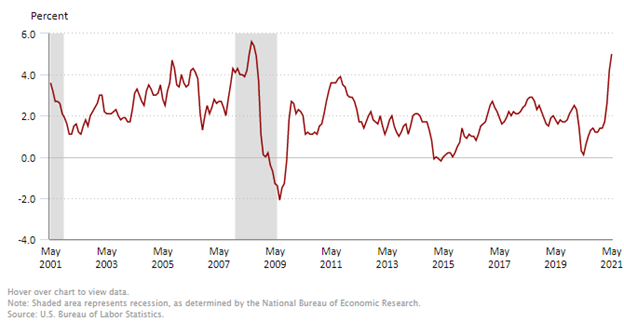CONSERVE. PLAN. GROW.®
As the economy reopens and we begin our post-pandemic lives, the world is starting to feel normal. However, many market prognosticators are calling for something that has not been present in America for a long time – a sustained period of above average inflation.
Resurgent demand bolstered by mass vaccinations, economic stimulus, and low interest rates have met a disrupted supply chain that has begun to come back online. Consumer balance sheets indicate a record level of savings, and restrictions being lifted around the country have brought back spending. The pent-up demand is noticeable, whether walking through an airport or making a dinner reservation.
Meanwhile, stress on global supply chains has been well documented as problems related to shipping, homebuilders, and microchips make daily headlines. Each industry and cog of the economy has its own unique set of problems contributing to global bottlenecks. Recent ransomware attacks on Colonial Pipeline and the world’s largest meat supplier, JBS, have contributed to shortages and price increases as well.
The price increases anecdotally observed are being confirmed by the recent data. The chart below of the 12-month percentage change in the Consumer Price Index (CPI) shows inflation over the past 20 years. In May, The Bureau of Labor Statistics (BLS) reported that CPI rose 5% over the last 12 months, the largest increase since August of 2008. Digging deeper, the BLS reported used car prices increased 30%, with the energy component of this index up 29%.

As costs rise in various segments of the economy, it can be difficult to discern which economic sectors are experiencing short-term price increases, referred to as “transitory” inflation and which categories are likely to see sustained inflation over time. Currently, most Fed policymakers hold the view that price increases are indeed mostly temporary. In comments made to a congressional oversight panel on June 22, Federal Reserve Chairman Jerome Powell said, “the data are very much consistent with the view that these factors will wane over time and then inflation will move down toward our goals.”
Historically, price increases caused by disruptions in the supply chain have tended to be temporary, and it is reasonable to expect imbalances to eventually ease. The unprecedented nature of a sudden economic halt without a defined reopening has made it difficult to discern when transitory price increases will abate.
It is typical for commodity prices to fluctuate; however, wage increases tend to have more staying power, and the labor market appears to be heating up. Job openings, quit rates, signing bonuses, and improving benefits are all pointing to wage growth. The service industry is seeing pressures, as a shortage of labor (for a variety of reasons) is creating challenges for retail, restaurants, and the travel & leisure industry. The manufacturing sector is dealing with similar labor supply issues. When possible, these labor costs will likely be passed along to the customer, and those costs will likely work their way through to the inflation data.
PORTFOLIO IMPLICATIONS OF INFLATION
Inflation can be a difficult subject to address in any broad sense because inflation is personal. No matter the environment, people have a preconditioned stance on inflation, and often for good reason. Views on inflation will be influenced by personal experiences and expenses. As discussed above, the most widely used indicator of inflation is the Consumer Price Index (CPI). CPI measures the average change in prices over time that consumers pay for a basket of goods and services. CPI has many limitations, and the measured basket of goods is unlikely to reflect one’s personal experiences. Age, lifestyle, cost of living, healthcare needs, and education expenses are just some of the major variables informing views of inflation. The aggregate data will likely not represent your own spending.
Additionally, many remember the period often referred to as “The Great Inflation” in the 1970s, where people stood in line as gas prices quadrupled and stomached double-digit mortgage rates. The U.S. dollar depreciation was severe, and many families saw the value of their savings slashed as inflation reached 14% in 1980. It is no surprise inflation carries such a negative connotation.
It has been a while since inflation fears headlined financial news coverage, but regardless of how the inflation picture plays out, it is important to remain focused on investing with a long-term view. While not a panacea, we believe our balanced portfolio construction approach is a valuable tool to mitigate the long-term impact of inflation. Central to our strategy is that we invest in high-quality businesses with sustainable competitive advantages. These businesses should be better prepared for inflation because they are ultimately able to pass through input cost increases to customers in the form of higher prices.
We also tend to favor bonds with shorter durations. Inflation and interest rates often go hand in hand. By favoring short-term bonds, as rates rise, we can reinvest proceeds at higher yields as bonds come due. We are careful not to extend our interest rate risk with longer duration bonds, as we do not want to be in a position where income from bonds fails to keep pace with inflation.
In summary, a balanced, diversified portfolio of quality investments is the best way to help our clients navigate unpredictable economic conditions. Be sure to let us know if you have questions or if you would like to discuss your investment strategy.
